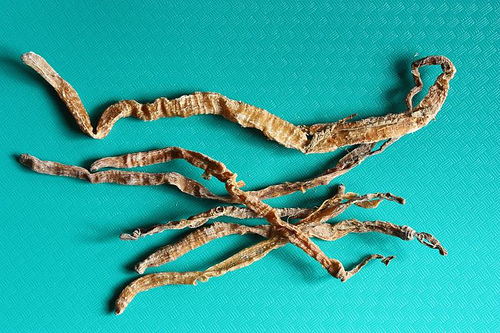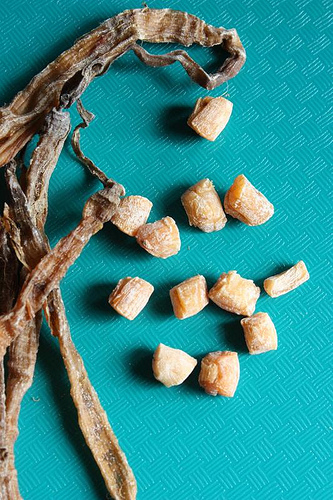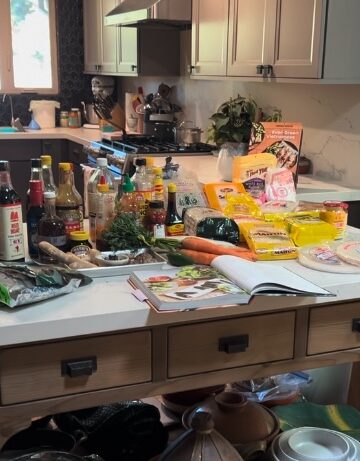
If you read Saveur magazine, you may have seen the northern pho (pho Bac) article that I wrote for the March 2011 issue. One of the ingredients that I mentioned in the story was sa sung (Sipunculans), dried peanut earthworms that add a unique savory sweetness to the broth. My cousin Quyen, Metropole Hotel Chefs Nguyen Thanh Van and Nguyen Thi Kim Hai, along with other Hanoians that I interviewed for the story talked about using the worms for their pho broth. They spoke of cooking with sa sung in a matter of fact manner.
I’d read about sa sung in Chef Didier Corlou’s cookbook, Ma Cuisine du Vietnam, but he wasn’t clear about what the worms did to the broth. Plus, the dried worms are not available abroad.
In the Saveur story (I know, it’s terrible that my surname was misspelled but it happens), I suggested dried scallops as a substitute. They work very well. However, sa sung is a nifty ingredient that I want to highlight on this site. For those of you visiting Vietnam, it’s a great food travel souvenir. Maybe there’s a food importer and distributor who will make them available for cooks outside of Vietnam! Below is information that I’ve gathered on the dried earthworms.
What are Sipuncula?
They’re marine (sea) worms that were first described in 1827 by a French zoologist. There are over 140 different kinds of them, and some are teeny tiny (2 millimeters long) while other can be as long as 28 inches.
Sipuncula nudus, between 6 and 10 inches long, is the kind employed by cooks in Vietnam and Southern China, primarily in Guangong, Hainan, Guanxi and Fujian. The Chinese names include: beihai shachong (北海沙虫, north sea sandworm) and tusun (土笋, earth bamboo shoot). The worms are sometimes featured in aspic as a Chinese delicacy.
In English, Sipuncula nudus is often referred to as peanut earthworms. I suppose it’s because the worm can look like a peanut. It doesn’t have segments but has a large flask-like section with a proboscis that can retract. Think of pushing the finger of a glove inside out.
Watch this YouTube video and at minute 3:40, you’ll see Vietnamese people harvesting sa sung worms at low tide:
[Note: This video is in Vietnamese and it praises Hanoi pho, which many consider to the best. I do agree with that notion. The video reenacts a vendor selling pho with a shoulder poll set up.]
What does the worm do to pho broth?
It’s a dried marine product that’s full of umami, a deep savory-sweetness. When I add sa sung to the pot, the broth becomes remarkably fragrant. The above video says that sa sung were an old school pho broth ingredient that few people use nowadays.
I beg to differ as the Hanoians I interviewed last summer said that it’s a great workaround for MSG. Northern Vietnamese cooks add dried seafood to meat-based noodle soup broths such as bun thang, which combines pork, chicken, dried squid, and dried shrimp. It’s not as crazy as you may think.
Where do you buy sa sung?
In Hanoi, I got my stash at Dong Xuan wholesale market in the dry foodstuffs area in a building in the back of the main one. The peanut earthworms are said to be sold at regular markets but I only went to Dong Xuan. I’ve not seen them sold in the U.S. Perhaps dried peanut earthworms available at Chinese herbal shops or dry goods store? Do you know?
How do you buy the dried earthworms?
I was told to buy the brown, rather ugly sa sung as the white ones had been overly processed. The Dong Xuan vendor told me that the brown ones were local, Vietnamese ones where as the white ones where Chinese and perhaps not to be trusted. Go figure. In any event, I listened to her and purchased 100 grams for not much money. I honestly can’t remember but the sa sung weren’t costly. Once home, I frozen them in zip-top plastic bags.
What do you do with the worms?
They’re sandy and you need to roast them in a dry skillet. Use medium heat and turn and shake the skillet until you can smell the worms’s fragrance, they puff up a bit, and darken. Let them cool on a plate, then break them into sections and shake out the sand. Finally add them to your pot of pho broth.
For my usual batch of pho, I used ½ ounce, which is rough 8 sa sung worms. I found that the broth did not need additional yellow rock sugar.

Waaaah. I have no worms!
Don't despair. Use dried scallops as I mentioned above! They have a similar quality. I buy small, cheap ones from the refrigerated section of a Chinese market. Look for dried shrimp and you’ll find dried scallop. Mine are no wider than a dime. You’ll pay lots more for dried scallop that are the size of domino pieces.
Are you familiar with these worms in either Vietnamese or Southern Chinese cooking? Do you know of a source outside of Vietnam?

















medical billing software says
How can I make chocolate chip cookies?
Jordan Team Elite says
Difficult circumstances serve as a textbook of life for people.
Eve says
There's something rare and beautiful about a post describing how to procure and use dried worms in pho, with a comment spammer asking how to make chocolate chip cookies.
Simon Bao says
Andrea, as I was reading, I had a feeling that whatever the worms were, they were going to turn out to be all about Umami.
The Sá Sùng worms looked vaguely familiar, but then I Googled around a bit and found the image at this page below, and I now feel very sure I have seen those dried worms, seen them at least a few times, and seen them in someone's kitchen here in Philadelphia. I just cannot recall whose kitchen it is.
http://www.simplevietnam.com/article/view/id/738
My recognizing dried Sá Sùng worms doesn't mean they are sold somewhere in Philadelphia. Every time someone comes back from a trip to Vietnam, all kinds of interesting, rare, and renegade food items show up in kitchens. I recall seeing these worms, thinking at first they were some kind of dried bamboo, then smelling and touching them and realizing they surely were not. I will ask around and see if I can find out who had worms and where they got them.
Helen says
When I first saw the name of this article I thought that it was just a leaf or so that looked (and was named after) like a worm. After I found out it was a real worm I reiterated to myself my three food rules (no bugs, no brain, no balut) but I don't know why it seems so much easier to stomach after you told us that they were sea worms...
I think I'll just use the dried scallops but if one day I actually get to go to Vietnam, I will keep an open mind!
Eastwood Residences says
Very interesting, I never thought dried worms can be useful.
Diane says
I think I may have seen these when snorkeling last year, but not sure. The local Thai people did harvest them, but I was told they mainly sold them to the Chinese and didn't eat them themselves. I will look for them the next time I'm in Oakland Chinatown. I don't really make pho though, so it would probably just be for my own interest. I do buy dried scallops from time to time - they are a umami blast.
Andrea Nguyen says
Oh yes -- you spammers -- can't you come up with something better than wormy chocolate chip cookies?
Andrea Nguyen says
Simon: If you can remember your worm source, that would be great.
Diane: I'm thinking a Chinese medicine shop or dry foodstuffs store may have them tucked away. Remember the Chinese names and characters, if possible.
Helen: Very funny -- marine worms are more palatable than your garden-variety earthworms. Marine worms do sound sexier...!
Eve says
The funny thing is that those worms are actually about as closely related to earthworms as you and I are related to starfish.
"Worm" tends to be a default term for all sorts of animals that are limbless, elongated and squishy. Unless you get them under a microscope they mostly look pretty similar to humans who aren't biologists, but they're actually amazingly diverse.
Ivy Manning says
Congratulations on the Saveur article! Beautiful! I'll have to ask my Hanoi friends about the earthworms in pho thing, they'll be so impressed I know! Thanks A!
My Kieu says
I know at least one Northern style shop in Sai Gon that uses dried squid, which works well, too.
Mike says
I found this post quite fascinating. It reminds me about how a lot of Koreans use dried anchovies or pollack to create a clean yet deep, savory stock. Now I'm really curious as to how broth with sa sung tastes like!
Andrea Nguyen says
Eve: In the case of sa sung, my sense is that they are genuinely a type of worm. They are members of the Sipuncula family of marine worms: http://en.wikipedia.org/wiki/Sipuncula
Ivy: You'll totally blow your Viet friends by sharing your knowledge of sa sung (sah soong).
Mike: I'm right with you. The Korean and Japanese use of the little dried fish for everyday stock echoes the same idea as using the worms. Shave bonito flakes (katsuo bushi) is in the same camp.
My Kieu: You'd think that a northern pho shop in Sai Gon would get the real sa sung from Ha Noi.
Laura Kelley says
Hi Andrea:
Really like this post and article. I also like how you found that the broth didn't need sugar after the worms were added.
There seems to be a Vietnamese exporter (LAA Sea worms (who knew?)) who is selling them dried and frozen on the web:
http://laa.com.vn/worm/index.php?route=product/product&product_id=52
They are claimed to be good for animal feed - no human culinary use is mentioned, so I would check how they were processed.
They are apparently very good for kidneys as well and can reverse the effects of glomular sclerosis (at least in rats).
Great post!
Laura
Laura Kelley says
Laura here, again:
Apparently, the exporter noted in my previous post, also ships them live to the US - and yes they arrive live as well. . .
Laura
Andrea Nguyen says
Laura -- OMG what great sleuthing on the health benefits and a source. Thank you. Animal feed? My goodness.
OysterCulture says
I read with interest your post in Saveur, and loved it. I also really enjoyed learning about this new ingredient. How I'd love to do a side by side taste taste to really appreciate the flavors that it brings to the pho.
Supra Shoes says
Really? Admirable but useless. Look, everyone knows that Blanton will be the first guy out the door in a trade to lower the payroll. And with Andy Petitte having retired, Brian Cashman will come calling for Fat Joe any day now if not already.
Supra Shoes says
Finally, the recipe called for instant yeast and had multiple rises? Totally wacky. Instant yeast is supposed to be used for one-rise breads. Maybe try again with active dry yeast. The steps of the recipes read fine for using that.
Chris says
Hawkers using earthworms to flavour laksa broth used to be an urban legend in Singapore a few decades ago...i wonder if some tangled cross-cultural story bleed is to blame...
Sodium lauryl sulfate says
So glad that you all enjoyed the photos and story. We were a lucky, well-fed family! It's definitely a time to think about moms, being a mother, women we admire -- all those good things.
Moncler outlet says
It was only when I saw my beautiful boy's grandparent's wedding photographs I realised why wedding photographs are so important. They are no for us. They are for our future.
how to be an extreme couponer says
I have to admit, ingesting earthworms in any form makes me shudder. I should get over that.
vi da nam says
Many Hounders have professed their mom's pho to be the best. I am no different, and recently asked my mother to share her secret to the amazing steaming hot bowls of lovin' that grace our table when I come home to visit the Pacific Northwest.
vitamins for hair growth says
Yes, sherry-soaked anise stars are the secret to my mom's incomparable bowl of pho bo (for you whitey tighties in the audience, or just newcomers, bo is beef). You basically buy the most crappy sherry available, fill a used Smucker's jam jar to the gills with anise stars, and pour. It must steep at least a few months to taste right for soup. I don't know if that's useful (or just gross) to anyone else. Thought I would share.
Sien Huat says
i saw that video has the black cardamoms on the table. i have found from internet that some pho bo used it in the recipe, what's the different of using black cardamoms? Also, by adding coriander will make the soup taste different?
rigging training says
Asian cuisine can be the tastiest and the weirdest delicacies in the world. This is not the first exotic ingredient I've heard when I started learning about this amazing culture.
Michelle Vuong says
you can buy dried sa sungs in some secialty shops that sell only dried asian products on stockton st. in china town in san francsico. $85.00 a pound.
michelle
Jordan 2012 says
I have to admit, ingesting earthworms in any form makes me shudder. I should get over that.
Quyen says
Ever since I read your article in Saveur, I've been wanting to make this. So today I finally bought a big stock pot at the restaurant supply store. I'm so excited to make pho at home even though it's just too easy and tempting to go to a pho place in San Jose and eat it right away! Thanks for the info on the worms. Will definitely look for them in the Chinese herbal stores. I've seen some pretty weird things in those places...
Michelle Vuong says
Yesterday I used sa sung to make stock for vietnamese beef stew and it turned out pretty tasty, no need for sugar ot msg. Next time I will use it in hu tieu".
Salvia says
The use of earthworms is an ecological acceptable method for breaking down organic materials that have been mixed with soils. Instead of composing these materials worms can be multiplied, grown and harvested and used as a supplemental protein source to feed livestock stock . This is a method of converting organic waste materials into a viable supplemental protein source, while enhancing the soil characteristics.
marlon says
I read with interest your post in Saveur, and loved it. I also really enjoyed learning about this new ingredient.
Tuan says
I'm from Toronto and my father goes to Vietnam every other year and the last time he brought back 2 huge bags of this stuff. At first I was iffy about it but after having this in my mom's famous Pho it took it to a whole new level. These "worms" aren't too bad. Has a nice texture and taste... kinda like calamari but better. LOL
expiring domains says
Hi there, I found your blog via Google while searching for a related topic, your site came up, it looks good. I have bookmarked it in my google bookmarks.
Alice says
The worms are a tasty (expensive) snack once they've been fried in a bit of oil. Let them cool a bit and they'll have a chip like texture. 🙂
My family bring back bags of the worms whenever they go to Hainan Island in China (very close to Vietnam) but I have never heard of them being available to purchase in Los Angeles. My mother carefully rations them out so she always has a stash on hand!
Andrea Nguyen says
Love this bit of insight, Alice! The worms are precious little guys. Wow, deep fried.
Dinh says
I've never tried it but heard someone recommend this website on a Facebook Vietnamese cooking group:
https://www.sasungusa.com
I'm not a seafood lover to begin with so I'm honestly not interested in this secret ingredient. Do you eat the worms too or just use it for flavoring like the spices?
Andrea Nguyen says
It's use in broth like a spice/seasoning. I have heard of people frying it up, though. The folks in charge of that sa sung website have been circulating the URL. Thanks for posting!
John J Lechanski says
Would you recommend the Sa Sung on their website? Is it reputable? Is it worth the price or is the dry scallops just as good? Thanks for your insight!
John says
Hi Andrea,
I know it's been awhile, but I found an outside source for Sa Sung (Sipunculus Nudus). I don't know how good it is, but I bought a very small amount to try. I wonder if you'd agree that this is a good source. Love your page, thanks for all the wonderful information!
Andrea Nguyen says
Those look very clean but I've not tried them out myself. I still have a big bag in my freezer. I suppose that if they're export quality, they should be good. Try them out and please share your feedback on this post. It would be super helpful.
John J Lechanski says
Got them in the mail today, will post after using it!
Andrea Nguyen says
Fantastic! Thanks.
r says
If we are substituting sa sung with dried scallops, how much dried scallops should we use?
Andrea Nguyen says
It's a straight weight substitution that's 1:1. Very simple!